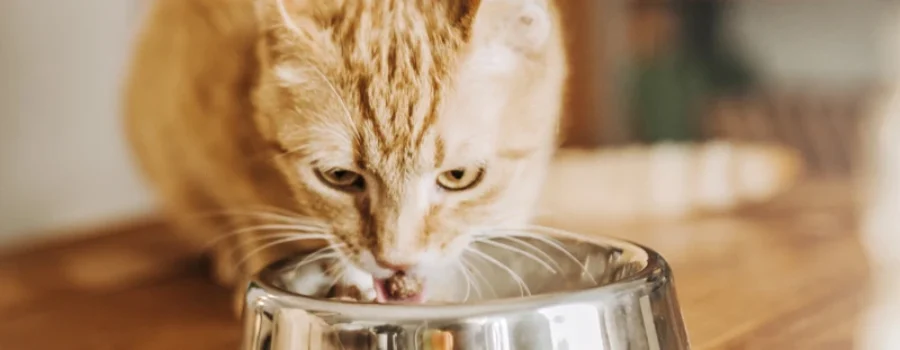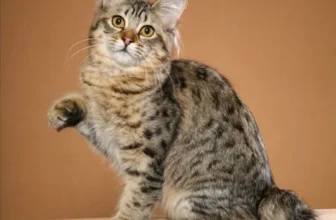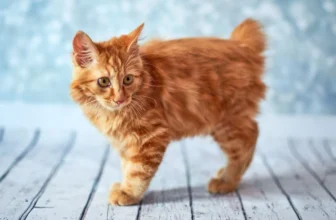As pet owners, we all want our American Bobtail cats to stay healthy and live long lives. While there are many factors to consider, one of the most important is portion control when feeding our furry friends. It can be perplexing to know how much to feed and what exactly to feed them. But fear not, with a little guidance and education, you can ensure that your cat gets the right nutrition in the right amounts. In this article, we will explore the importance of portion control for American Bobtail cats, how much to feed them, what to feed them, and some helpful tips and advice to ensure that your cat stays happy and healthy.
Why is Portion Control Important?

Portion control is an essential part of maintaining your American Bobtail cat’s health and overall well-being. By controlling the amount of food your cat consumes, you can prevent several chronic diseases and maintain an optimal weight. To understand why portion control is important for your feline friend, we’ll delve into the details of weight management, digestive health, and avoiding chronic diseases. Let’s explore the significance of portion control for American Bobtail cats. To learn more about the dietary needs of American Bobtail cats, you can check out our article on food for American Bobtail cats.
Weight Management
Maintaining a healthy weight is crucial for your American Bobtail’s overall health and well-being. Overfeeding your cat can lead to obesity, which can increase the risk of various health problems. On the other hand, underfeeding can cause malnutrition and other health complications. Feeding your American Bobtail the right portion is essential for its weight management.
Obesity in cats is a common problem that can lead to serious health issues, such as diabetes, cardiovascular disease, and arthritis. To prevent obesity, you should monitor your cat’s weight regularly and adjust its diet accordingly. A healthy adult American Bobtail cat should weigh between 8 and 15 pounds. If you notice that your cat is overweight or underweight, consult with your veterinarian for advice on how to manage its weight.
The chart below provides an estimate of the daily caloric requirements for American Bobtail cats based on their weight:
| Weight Range | Calories per Day |
|---|---|
| 8-10 pounds | 240-300 |
| 10-12 pounds | 300-360 |
| 12-15 pounds | 360-450 |
It’s important to note that these are just rough estimates, and your cat’s specific needs may vary based on its activity level, age, and other factors. Consult with your veterinarian for more personalized advice.
Underfeeding your American Bobtail can also cause health problems. Kittens, for example, require more calories for growth and development. If you have a kitten, make sure to feed it a diet that is specifically formulated for kittens, and follow the feeding guidelines on the food label. As your kitten grows, adjust its diet to match its weight and age.
Portion control is key to managing your American Bobtail’s weight. Keeping your cat at a healthy weight can help prevent various health problems and ensure its overall well-being. For more information on what to feed your American Bobtail, check out our article on food for American Bobtail cats.
Digestive Health
Proper portion control plays an important role when it comes to maintaining the digestive health of your American Bobtail cat. Overfeeding or underfeeding your cat can lead to gastrointestinal problems like constipation, diarrhea, and vomiting, which can result in discomfort and poor nutrition.
Here are some ways portion control can promote good digestive health in your American Bobtail:
| Benefits of Portion Control for Digestive Health | How to Achieve Portion Control |
|---|---|
| Prevents overeating, which can cause indigestion and bloating | Measure out your cat’s food using measuring cups or a scale to ensure you’re feeding the right amount |
| Encourages slow and steady eating, which aids digestion | If your cat eats too fast, use a slow feeder bowl to promote slower eating habits |
| Regulates bowel movements, reducing the risk of constipation or diarrhea | Feed your cat on a fixed schedule rather than free-feeding, to promote regular bowel movements and a healthy digestive system |
Another important factor for good digestive health in American Bobtail cats is the quality of the food you feed them. Opting for high-quality, protein-rich foods can help maintain a healthy digestive tract. Additionally, avoiding foods that contain fillers, grains, and artificial preservatives can help reduce the risk of digestive issues.
Here are some links that can help guide you in choosing the right food for your American Bobtail:
– Top 5 Cat Food Brands for American Bobtails
– Feeding Bobtail Kittens
– Best Homemade Cat Food Recipes for American Bobtail
By following portion control guidelines, feeding high-quality food, and paying attention to your cat’s digestive health, you can help ensure they live a happy, healthy life.
Prevention of Chronic Diseases
It’s crucial to maintain the right portion control when feeding your American Bobtail cat in order to prevent chronic diseases. Overfeeding and underfeeding can result in serious health issues for your furry friend.
- Obesity: Overfeeding your American Bobtail cat can lead to obesity, which not only impacts their quality of life but can also lead to other health problems like diabetes, heart disease, and arthritis. Obesity also puts your pet at a higher risk of developing certain types of cancer. Cats who are overweight have a shorter lifespan compared to those who maintain a healthy weight.
- Urinary tract disease: Overfeeding your cat can lead to urinary tract diseases which can be very painful and if left untreated, can even be fatal. These diseases can be caused by a number of factors including poor diet, lack of exercise, and poor grooming habits.
- Dehydration: Underfeeding your cat can lead to dehydration which can cause serious health issues including urinary tract infections, constipation, and kidney damage. Dehydration can also occur when cats are not provided with fresh water or when they have an underlying medical condition.
It’s important to note that portion control alone cannot prevent chronic diseases, but it can definitely reduce the risk factors associated with them. Making sure your American Bobtail cat gets the right amount of food, as well as a balanced and nutritious diet, is key in maintaining their health.
For more information on feeding your American Bobtail cat, check out our guide on free-feeding versus timed feeding and our treat guide. However, be sure to avoid feeding your cat certain human foods, as some can be highly toxic for them. Check out our guide on what not to feed your American Bobtail cat for more information.
How Much to Feed Your American Bobtail Cat
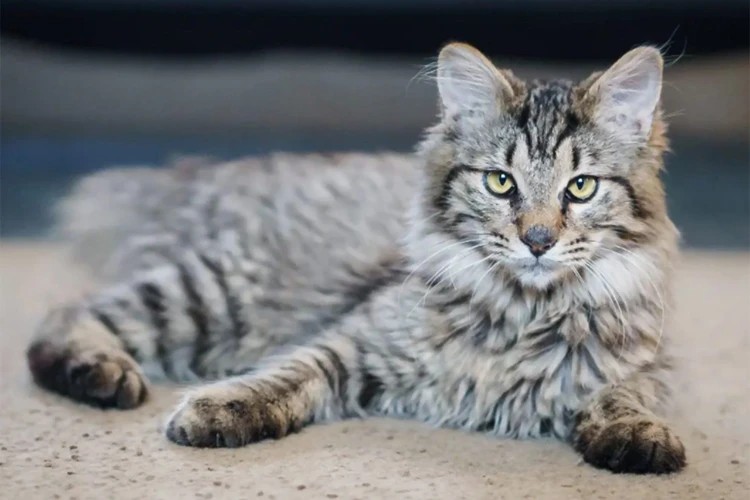
As a responsible pet owner, determining just how much to feed your American Bobtail cat can be a perplexing task. You want to ensure that your feline friend receives all the necessary nutrients for optimal health, while avoiding overfeeding and the associated health risks. In this section, we’ll explore the caloric requirements of American Bobtail cats, how to read food labels, and the importance of establishing a feeding schedule. By the end, you’ll have a better understanding of how much to feed your furry friend to keep them happy and healthy.
Caloric Requirements
Knowing the caloric requirements of your American Bobtail cat is crucial when it comes to portion control. Overfeeding can lead to weight gain and obesity, while underfeeding can lead to malnutrition and a weakened immune system. The exact caloric requirements vary depending on the cat’s age, weight, and activity level.
To determine the recommended daily caloric intake for your American Bobtail, refer to the following general guidelines:
Weight | Calories per Day
—|—
4 lbs | 200-250
6 lbs | 250-350
8 lbs | 300-400
10 lbs | 350-450
12 lbs | 400-500
14 lbs | 450-550
Keep in mind that these are just guidelines, and your cat’s specific needs may differ. It’s always best to consult with your veterinarian to determine the ideal caloric intake for your American Bobtail. Additionally, adjust their diet as necessary based on any changes in weight, age, activity level, and overall health.
It’s worth noting that not all cat foods are created equal when it comes to caloric content. Some brands may contain more calories per serving than others, even if the serving size is the same. It’s important to understand food labels and pay attention to the caloric content per serving. Some foods are formulated specifically with weight management in mind, so consider looking for those if your American Bobtail needs to lose or maintain weight.
Ultimately, portion control is key when it comes to keeping your American Bobtail healthy and happy. By following the recommended caloric intake and monitoring their diet closely, you can help prevent a host of health issues and ensure they live a long, fulfilling life.
Understanding Food Labels
When it comes to portion control, understanding food labels is crucial for ensuring that your American Bobtail cat is getting the right amount of nutrients. Before purchasing cat food, it’s important to familiarize yourself with the information listed on the label.
The following table provides an overview of the key information found on cat food labels:
| Term | Meaning |
|---|---|
| Guaranteed Analysis | This section provides information on the percentage of protein, fat, fiber, and moisture in the food. |
| Ingredients List | This list shows all the ingredients included in the food. Ingredients are listed in order of weight, with the heaviest ingredient listed first. |
| Feeding Instructions | This section provides information on how much food to feed your cat based on their weight and age. |
| Calories | This information shows the number of calories in each serving of food. Be sure to take note of the serving size to ensure you’re not overfeeding your cat. |
Understanding these terms can help you make informed decisions about the products you purchase for your American Bobtail cat. When reading the ingredients list, look for high-quality sources of protein, such as chicken, turkey, or fish. Avoid foods that contain fillers like corn, wheat, and soy as they offer minimal nutritional value.
It’s also important to pay attention to the feeding instructions and caloric content on the label. Overfeeding can lead to weight gain and a higher risk of chronic health problems, so be sure to follow the guidelines provided. If you’re unsure about how much to feed your cat or which food to choose, consult with your veterinarian for advice.
Feeding Schedule
Creating a proper feeding schedule is crucial when it comes to enforcing portion control for your American Bobtail cat. An inconsistent feeding routine is not only unhealthy for your pet, but it can also lead to overeating and weight gain. Follow the feeding recommendations from your cat food packaging or consult with your veterinarian to create a feeding schedule that is appropriate for your pet’s age, weight, and activity level.
It is recommended to feed adult American Bobtail cats several small meals per day instead of one large meal. Divide the daily recommended amount of food into three or four smaller portions and feed your cat at regular intervals throughout the day. This routine helps to keep your cat’s metabolism stable and prevents them from feeling too hungry or too full at any given time.
Below is a sample feeding schedule for adult American Bobtail cats based on their weight and daily caloric requirements:
| Weight of Cat | Daily Caloric Requirement | Feeding Schedule (Three Meals) | Feeding Schedule (Four Meals) |
|---|---|---|---|
| 5-7 lbs | 180-200 | 60-70 calories per meal | 45-50 calories per meal |
| 8-10 lbs | 280-300 | 90-100 calories per meal | 70-75 calories per meal |
| 11-13 lbs | 360-380 | 120-130 calories per meal | 90-95 calories per meal |
| 14-16 lbs | 440-460 | 145-155 calories per meal | 110-115 calories per meal |
Remember to adjust the feeding schedule as necessary based on your cat’s individual needs, metabolic rate, and activity level. You should also be aware of any changes in weight and adjust the schedule accordingly to maintain a healthy weight and lifestyle.
What to Feed Your American Bobtail Cat
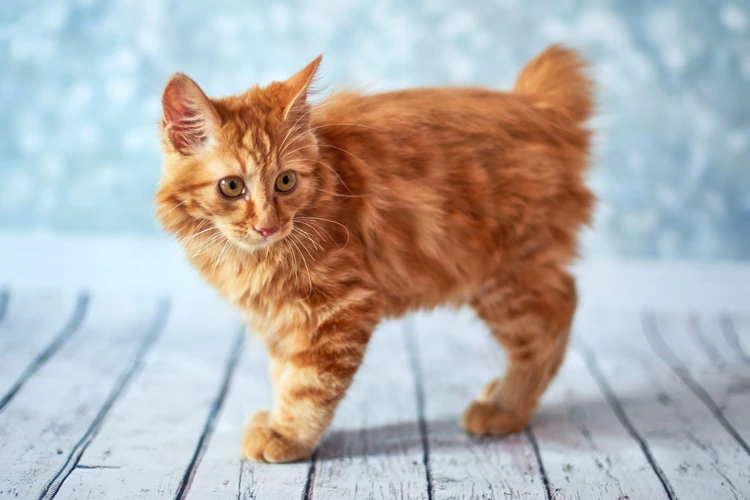
Choosing the right food for your American Bobtail cat can be a perplexing task. With so many options available, picking the one that will meet your cat’s nutritional needs can be overwhelming. However, finding the right balance of protein, fats, carbohydrates, vitamins and minerals is crucial when it comes to ensuring the health of your pet. In this section, we will provide you with all the necessary information on what to feed your American Bobtail cat. So, let’s dive in and discover how to make informed decisions about your cat’s diet.
Protein Requirements
As obligate carnivores, American Bobtail cats require high amounts of protein in their diet. Proteins are essential elements that help build and repair muscles and tissues, support the immune system, and provide energy for daily activities.
Animal proteins, such as those derived from chicken, turkey, beef, and fish, are recommended for American Bobtail cats. These proteins provide essential amino acids that the cat’s body cannot produce on its own.
It is important to note that not all protein sources are the same. Some cat foods use plant-based proteins, such as those from peas, lentils, and soy, which may not provide the same quality of nutrition as animal-based proteins. Look for cat food that includes easily digestible animal proteins, ideally as the first ingredient listed on the label.
The amount of protein a cat needs depends on a variety of factors, such as age, weight, and activity level. Typically, adult cats require at least 25-30% of their diet to be protein, while kittens require even more – up to 40% of their diet.
To ensure that your American Bobtail cat is getting the proper amount of protein, read the cat food label and choose a food that meets their specific protein needs. It is also important to note that if you choose to feed your cat a homemade or raw diet, you will need to work with a veterinarian to ensure that your cat is getting the right balance of nutrients, including protein.
By providing your American Bobtail cat with the right amount and quality of protein, you can help support their overall health and well-being.
Fats and Carbohydrates
When it comes to feeding your American Bobtail cat, it’s important to consider not only the protein requirements but also the fat and carbohydrate content in their diet. These are two essential nutrients that your cat needs on a daily basis to maintain optimal health and energy levels.
Fats are a great source of energy for cats, and they also play a crucial role in maintaining healthy skin, coat, and joints. However, too much fat in your cat’s diet can lead to obesity and other health problems. Carbohydrates, on the other hand, provide energy and help regulate blood sugar levels, but cats have a limited ability to digest carbohydrates compared to other animals.
It’s important to choose a cat food that has a balanced ratio of fats and carbohydrates, and that is appropriate for your cat’s age, weight, and activity level. Below is a table that shows the recommended percentage of fat and carbohydrates in a cat’s diet based on their life stage.
| Life Stage | Fat % | Carbohydrates % |
|————–|—————–|—————–|
| Kitten | 22-28% | 35-40% |
| Adult | 10-15% (average) | 3-10% (max) |
| Senior | 15-20% (max) | 3-10% (max) |
It’s important to note that these percentages may vary depending on your cat’s individual needs and health conditions. Some cats may require a higher fat intake to maintain a healthy weight or to support their skin and coat health. Others may have carbohydrate intolerance or diabetes, which requires a low-carb diet.
Consulting with your veterinarian is the best way to determine the appropriate fat and carbohydrate content for your cat’s diet, as they can perform a thorough health assessment and recommend a personalized feeding plan for your feline friend.
Vitamins and Minerals
When it comes to the overall health of your American Bobtail cat, ensuring that they receive a proper balance of vitamins and minerals is essential. Here are some key nutrients to include in your cat’s diet:
- Vitamin A: Necessary for maintaining healthy vision, skin, and coat. Sources include liver, fish, and eggs.
- Vitamin B: B vitamins play a critical role in many bodily processes, including energy production, immune function, and brain health. Sources include meat, dairy, and grains.
- Vitamin C: Not typically required in a cat’s diet, as their bodies can produce their own. However, it can offer some health benefits and can be found in small amounts in fruits and vegetables.
- Vitamin D: Critical for bone health and immune function. Most cats can get enough vitamin D from exposure to sunlight, but it can also be found in fatty fish and egg yolks.
- Vitamin E: An antioxidant that helps protect cells from damage. Found in oils, nuts, and seeds.
- Vitamin K: Plays a role in blood clotting and bone health. Found in liver and green leafy vegetables.
- Calcium: Important for strong bones and teeth. Can be found in dairy products, as well as in some vegetables such as kale and broccoli.
- Phosphorus: Works with calcium to strengthen bones and teeth. Found in meat, dairy, and grains.
- Potassium: Helps regulate fluid balance, nerve function, and muscle contractions. Found in meat, dairy, and some fruits and vegetables.
- Magnesium: Important for muscle and nerve function, as well as bone health. Sources include meat, dairy, and whole grains.
- Zinc: Critical for immune function, wound healing, and protein synthesis. Can be found in meat, dairy, and grains.
To ensure that your cat is receiving enough of these vital nutrients, it’s important to choose a high-quality cat food that includes a variety of protein sources and nutrient-dense ingredients. Always consult with your veterinarian to determine your cat’s specific needs and to discuss any supplements that may be necessary.
Tips and Advice for Portion Control
As a cat owner, you want to ensure that your American Bobtail cat stays healthy and happy for years to come. One way to do this is by practicing portion control when feeding your furry friend. While it may seem overwhelming to monitor your cat’s food intake, it’s an essential step towards maintaining their overall well-being. Here, we’ve compiled a few tips and advice to make the process easier for you and your cat.
Use Measuring Cups or a Scale
One effective way to control the portion size of your American Bobtail cat’s meals is to use measuring cups or a kitchen scale. Measuring cups allow you to accurately measure the volume of your cat’s food, while a kitchen scale can help you determine the precise weight of the food you’re serving. When using measuring cups or a scale, it’s important to pay attention to the recommended serving sizes on the cat food packaging or consult with your veterinarian to determine the appropriate amount of food for your cat’s specific dietary needs.
Measuring Cups:
Using measuring cups is one of the easiest and most convenient ways to ensure that your American Bobtail cat is getting the correct amount of food. Make sure to use dry measuring cups for dry food and liquid measuring cups for wet food. Dry measuring cups should be leveled off with a flat edge, while liquid measuring cups should be filled up to the appropriate line. It’s important to note that measuring cups come in different sizes, so make sure you’re using the correct size for the recommended serving size.
Kitchen Scale:
Using a kitchen scale is another way to accurately measure your cat’s food. It allows you to determine the precise weight of the food you’re serving, which can be especially helpful if you’re feeding your cat a combination of wet and dry food or if you’re trying to manage your cat’s weight. To use a kitchen scale, place a bowl on top of the scale and zero out the weight. Then, add the appropriate amount of food to the bowl and weigh it. This method is particularly useful for ensuring that your cat receives the exact amount of food that they need.
Incorporating measuring cups or a kitchen scale into your cat feeding routine can help you ensure that you’re accurately portioning your American Bobtail cat’s food. By doing so, you can help to prevent overfeeding, maintain a healthy weight, and promote overall good health.
Don’t Free-Feed
Free-feeding your American Bobtail cat can seem like a comfortable option, but it can lead to overeating, obesity, and other health problems. Free-feeding means leaving food in your cat’s bowl all day long, allowing them to eat whenever they wish. This approach can make it challenging to control how much food your cat is consuming. Additionally, it is difficult to keep track of your cat’s daily intake accurately.
The following table illustrates the dangers of free-feeding:
| Dangers of Free-Feeding | |
|---|---|
| Problem | Description |
| Overeating | Free-feeding makes it challenging to monitor your cat’s eating habits, leading to overeating and weight gain. |
| Obesity | When cats consume more food than their body needs, it can result in obesity, which can lead to various health problems. |
| Health Problems | Overeating and obesity can lead to health problems such as diabetes, heart disease, and joint pain. |
| Waste | Free-feeding can lead to food waste, as uneaten food may attract pests, spoil more quickly, or dry out. |
It is essential to avoid free-feeding your American Bobtail cat and instead adopt a portion-controlled feeding routine to ensure your cat gets the appropriate amount of food per day. By controlling the food intake of your cat, you can prevent excess weight gain, promote a healthy digestive system, and reduce the risk of chronic illnesses.
Instead of leaving food out all day, it is recommended to divide your cat’s daily intake into smaller meals and feed them on a schedule. This method will help you monitor how much food your cat eats, and it ensures that the food is fresh, and the feeding routine is consistent. With portion-controlled feeding, you can also better observe your cat’s dietary needs and make more informed decisions regarding their nutrition plan.
Avoid Over-Treating
As much as you may love spoiling your American Bobtail cat with treats, it is important to avoid over-treating them to maintain healthy portion control. Treats should make up no more than 10% of your cat’s daily caloric intake.
It can be tempting to give your cat treats whenever they meow or beg for them, but it is important to resist this urge. Instead of constantly handing out treats, find other ways to show affection towards your cat, such as playing with them or giving them extra attention.
Table: Common Cat Treats and their Caloric Content
| Treat Type | Calories per Serving | Serving Size |
|---|---|---|
| Dry Kibble Treats | 1-3 calories | 1-3 pieces |
| Canned Wet Food Treats | 20-100 calories | 1 tablespoon |
| Tuna Treats | 1-6 calories | 1 piece (about the size of a pea) |
| Chicken Treats | 5-10 calories | 1 piece (about the size of a thumbnail) |
When choosing treats for your cat, opt for low-calorie options such as dry kibble treats or small pieces of lean meats like chicken. Avoid giving your cat treats that are high in calories, such as canned wet food treats or treats with added sugars.
Remember, treats should only make up a small percentage of your cat’s overall diet. Over-treating can lead to obesity and a host of other health problems. By avoiding over-treating and sticking to an appropriate feeding schedule and portion control, you can help your American Bobtail cat lead a happy and healthy life.
Consult with Your Veterinarian
When it comes to the health and well-being of your American Bobtail cat, consulting with a veterinarian is crucial. A veterinarian can provide expert advice on how much to feed your cat and what type of food is best for their individual needs. They can also help you create a customized feeding plan based on your cat’s unique characteristics such as age, weight, and activity level.
During the consultation, the veterinarian will likely recommend specific brands of food and explain what ingredients to look for and what to avoid. They may also provide guidance on how to read food labels and check for adequate protein, fat, and vitamin content.
It’s important to note that every cat is different and may require different nutritional needs, so it’s critical to seek professional advice instead of relying solely on online resources or advice from other cat owners.
Additionally, a veterinarian can also provide you with appropriate portion sizes and feeding schedules based on your cat’s individual needs. They can also monitor your cat’s weight, body condition, and overall health on a regular basis, ensuring that they remain healthy and happy in the long run.
Consulting a veterinarian may also be necessary if you notice any changes in your cat’s eating habits, behavior, or overall health. This can help identify any potential health issues early on and prevent any serious problems from developing.
When it comes to feeding your American Bobtail cat, consulting with a veterinarian is always a good idea. They can provide expert advice on nutrition and help you create a customized feeding plan that will keep your cat healthy and happy for years to come.
| Key Takeaways: |
|---|
| Consulting with a veterinarian is crucial when it comes to the health and well-being of your American Bobtail cat. |
| A veterinarian can provide expert advice on nutrition, portion sizes, and feeding schedules based on your cat’s individual needs. |
| This can help prevent potential health issues and ensure that your cat remains healthy and happy in the long run. |
| Consult with a veterinarian regularly and especially if you notice any changes in your cat’s eating habits, behavior, or overall health. |
Conclusion
In conclusion, it is essential to ensure that your American Bobtail cat is receiving the right amount of food and nutrition in order to maintain a healthy weight and prevent chronic diseases. Portion control is crucial when it comes to feeding your cat as overeating can cause obesity, which can lead to health issues such as diabetes, heart disease, and joint problems. Therefore, it is important to monitor your cat’s feeding schedule and caloric intake.
To determine the appropriate amount of food to give your American Bobtail cat, it is necessary to understand their caloric requirements and read food labels carefully. A high-quality cat food that is rich in protein, healthy fats, and essential vitamins and minerals is ideal for maintaining a healthy weight and digestive system.
When it comes to portion control, measuring cups and scales are excellent tools for accurately measuring food portions. Free-feeding should be avoided as it can lead to overconsumption, and over-treating should also be limited as it can result in excess calorie intake.
Consulting with your veterinarian can also provide helpful advice on portion control and nutrition. Your vet can assess your cat’s individual needs and recommend the appropriate amount of food and type of diet.
Overall, practicing proper portion control and providing a well-balanced diet is essential for keeping your American Bobtail cat healthy and happy. By making sure your cat is receiving the right amount of nutrients and not overeating, you can help prevent health issues and ensure a longer life for your beloved pet.
Frequently Asked Questions
What are the benefits of portion controlling my American Bobtail cat’s food?
Portion control helps with weight management, digestive health, and can prevent chronic diseases.
How much should I feed my American Bobtail cat?
The amount of food your cat needs depends on their caloric requirements, which can vary based on their age, weight, and activity level.
What should I look for on food labels to determine portion sizes?
Look for the recommended serving size for your cat’s weight and the caloric content per serving. Also, pay attention to the ingredients to ensure your cat is getting the proper nutrients.
What are the protein requirements for American Bobtail cats?
Cats need a high-protein diet, and American Bobtails, in particular, require more protein than other breeds due to their muscular build.
Can I free-feed my American Bobtail cat?
It is not recommended to free-feed because it can lead to overeating and obesity. It’s best to stick to a feeding schedule and portion control.
What are some common health problems that can arise from overfeeding my cat?
Overfeeding can lead to obesity, diabetes, and urinary tract issues.
How can I ensure that my cat is getting all the necessary nutrients in their diet?
Choose a high-quality cat food that is labeled as nutritionally complete and balanced.
What are some signs that my American Bobtail cat is not getting enough food?
If your cat is losing weight or acting lethargic, it may be a sign that they are not getting enough food. Consult with your veterinarian to adjust portion sizes.
Can I give my American Bobtail cat treats?
Yes, but it’s important to do so in moderation and to choose healthy treat options. Avoid giving your cat human food, as it can cause digestive upset.
Why is it important to consult with a veterinarian before making changes to my cat’s diet?
Every cat has unique nutritional needs, and a veterinarian can help you determine the best diet and portion sizes for your American Bobtail based on their individual needs.

